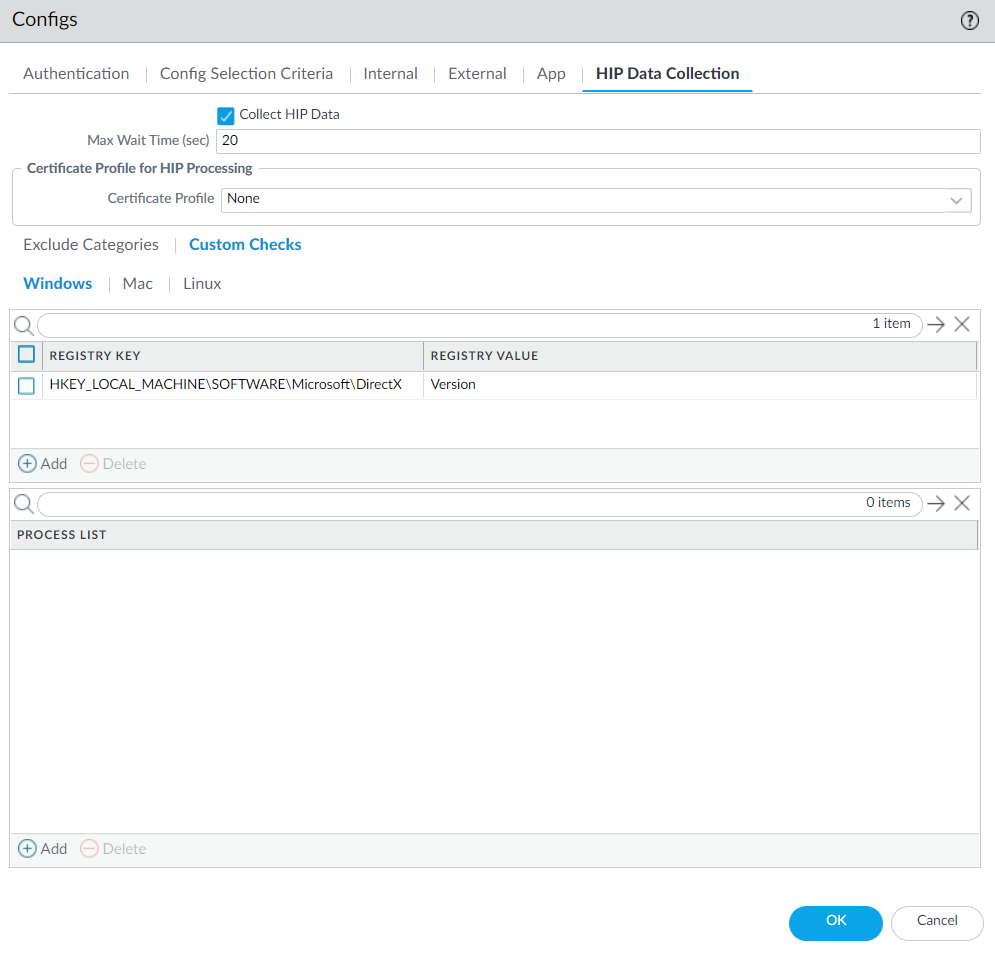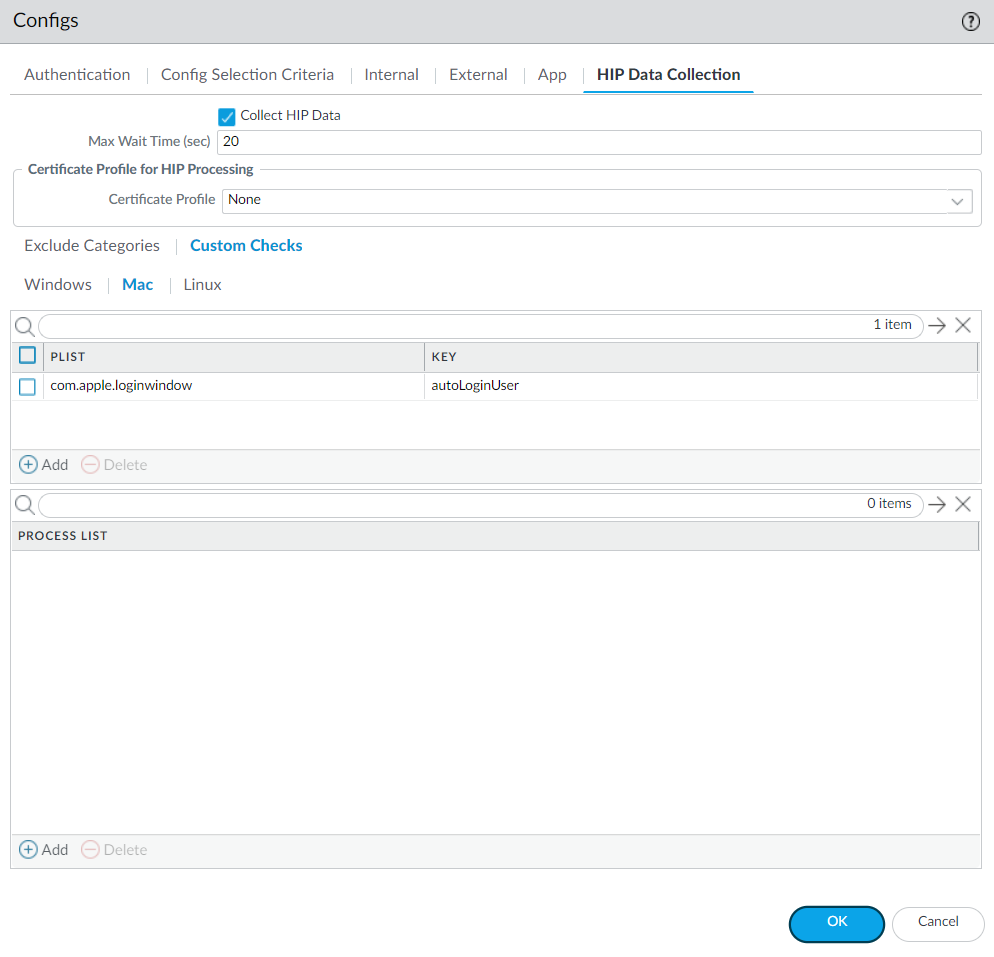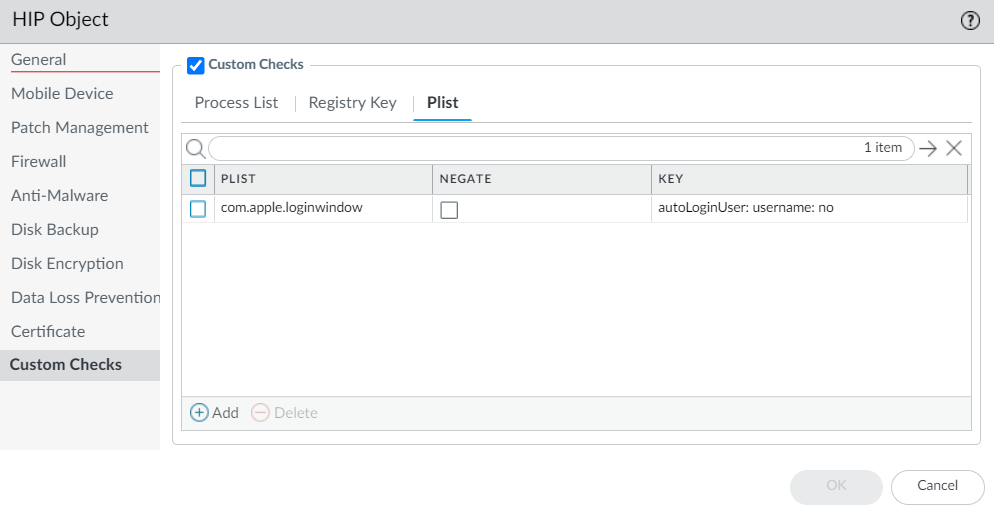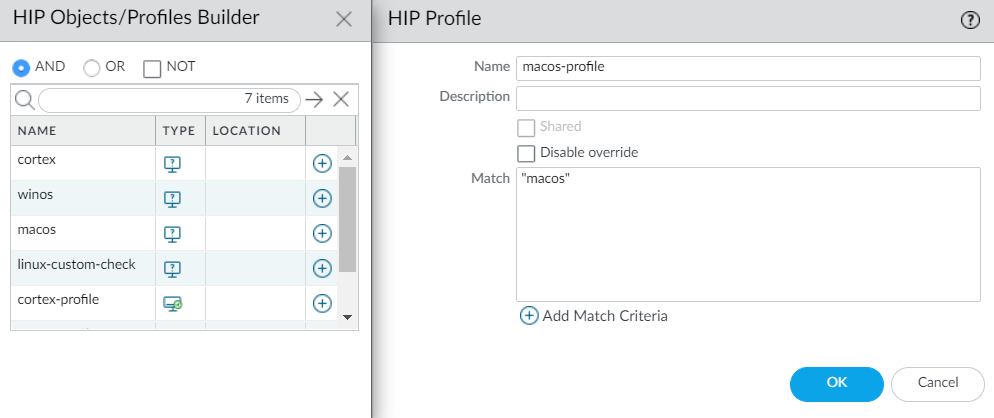GlobalProtect
Collect Application and Process Data From Endpoints
Table of Contents
Expand All
|
Collapse All
GlobalProtect Docs
-
10.1 & Later
- 10.1 & Later
- 9.1 (EoL)
-
- How Does the App Know Which Certificate to Supply?
- Set Up Cloud Identity Engine Authentication
- Configure GlobalProtect to Facilitate Multi-Factor Authentication Notifications
- Enable Delivery of VSAs to a RADIUS Server
- Enable Group Mapping
-
-
- GlobalProtect App Minimum Hardware Requirements
- Download the GlobalProtect App Software Package for Hosting on the Portal
- Host App Updates on the Portal
- Host App Updates on a Web Server
- Test the App Installation
- Download and Install the GlobalProtect Mobile App
- View and Collect GlobalProtect App Logs
-
-
- Deploy App Settings in the Windows Registry
- Deploy App Settings from Msiexec
- Deploy Scripts Using the Windows Registry
- Deploy Scripts Using Msiexec
- Deploy Connect Before Logon Settings in the Windows Registry
- Deploy GlobalProtect Credential Provider Settings in the Windows Registry
- SSO Wrapping for Third-Party Credential Providers on Windows Endpoints
- Enable SSO Wrapping for Third-Party Credentials with the Windows Registry
- Enable SSO Wrapping for Third-Party Credentials with the Windows Installer
- Deploy App Settings to Linux Endpoints
- GlobalProtect Processes to be Whitelisted on EDR Deployments
-
-
- Mobile Device Management Overview
- Set Up the MDM Integration With GlobalProtect
- Qualified MDM Vendors
-
-
- Set Up the Microsoft Intune Environment for Android Endpoints
- Deploy the GlobalProtect App on Android Endpoints Using Microsoft Intune
- Create an App Configuration on Android Endpoints Using Microsoft Intune
- Configure Lockdown Mode for Always On Connect Method on Android Endpoints Using Microsoft Intune
-
- Deploy the GlobalProtect Mobile App Using Microsoft Intune
- Configure an Always On VPN Configuration for iOS Endpoints Using Microsoft Intune
- Configure a User-Initiated Remote Access VPN Configuration for iOS Endpoints Using Microsoft Intune
- Configure a Per-App VPN Configuration for iOS Endpoints Using Microsoft Intune
-
-
-
- Create a Smart Computer Group for GlobalProtect App Deployment
- Create a Single Configuration Profile for the GlobalProtect App for macOS
- Deploy the GlobalProtect Mobile App for macOS Using Jamf Pro
-
- Enable GlobalProtect System Extensions on macOS Endpoints Using Jamf Pro
- Enable GlobalProtect Network Extensions on macOS Big Sur Endpoints Using Jamf Pro
- Add a Configuration Profile for the GlobalProtect Enforcer by Using Jamf Pro 10.26.0
- Verify Configuration Profiles Deployed by Jamf Pro
- Remove System Extensions on macOS Monterey Endpoints Using Jamf Pro
- Non-Removable System Extensions on macOS Sequoia Endpoints Using Jamf Pro
- Uninstall the GlobalProtect Mobile App Using Jamf Pro
-
- Configure HIP-Based Policy Enforcement
- Configure HIP Exceptions for Patch Management
- Collect Application and Process Data From Endpoints
- Redistribute HIP Reports
-
- Identification and Quarantine of Compromised Devices Overview and License Requirements
- View Quarantined Device Information
- Manually Add and Delete Devices From the Quarantine List
- Automatically Quarantine a Device
- Use GlobalProtect and Security Policies to Block Access to Quarantined Devices
- Redistribute Device Quarantine Information from Panorama
- Troubleshoot HIP Issues
-
-
- Enable and Verify FIPS-CC Mode on Windows Endpoints
- Enable and Verify FIPS-CC Mode on macOS Endpoints
- Enable and Verify FIPS-CC Mode Using Workspace ONE on iOS Endpoints
- Enable FIPS Mode on Linux EndPoints with Ubuntu or RHEL
- Enable and Verify FIPS-CC Mode Using Microsoft Intune on Android Endpoints
- FIPS-CC Security Functions
- Resolve FIPS-CC Mode Issues
-
-
- Remote Access VPN (Authentication Profile)
- Remote Access VPN (Certificate Profile)
- Remote Access VPN with Two-Factor Authentication
- GlobalProtect Always On VPN Configuration
- Remote Access VPN with Pre-Logon
- User-Initiated Pre-Logon Connection
- GlobalProtect Multiple Gateway Configuration
- GlobalProtect for Internal HIP Checking and User-Based Access
- Mixed Internal and External Gateway Configuration
- Captive Portal and Enforce GlobalProtect for Network Access
- GlobalProtect on Windows 365 Cloud PC
-
- About GlobalProtect Cipher Selection
- Cipher Exchange Between the GlobalProtect App and Gateway
-
- Reference: GlobalProtect App Cryptographic Functions
-
- Reference: TLS Ciphers Supported by GlobalProtect Apps on macOS Endpoints
- Reference: TLS Ciphers Supported by GlobalProtect Apps on Windows Endpoints
- Reference: TLS Ciphers Supported by GlobalProtect Apps on Android 6.0.1 Endpoints
- Reference: TLS Ciphers Supported by GlobalProtect Apps on iOS 10.2.1 Endpoints
- Reference: TLS Ciphers Supported by GlobalProtect Apps on Chromebooks
- Ciphers Used to Set Up IPsec Tunnels
- SSL APIs
-
- View a Graphical Display of GlobalProtect User Activity in PAN-OS
- View All GlobalProtect Logs on a Dedicated Page in PAN-OS
- Event Descriptions for the GlobalProtect Logs in PAN-OS
- Filter GlobalProtect Logs for Gateway Latency in PAN-OS
- Restrict Access to GlobalProtect Logs in PAN-OS
- Forward GlobalProtect Logs to an External Service in PAN-OS
- Configure Custom Reports for GlobalProtect in PAN-OS
-
6.3
- 6.3
- 6.2
- 6.1
- 6.0
- 5.1
-
- Download and Install the GlobalProtect App for Windows
- Use Connect Before Logon
- Use Single Sign-On for Smart Card Authentication
- Use the GlobalProtect App for Windows
- Report an Issue From the GlobalProtect App for Windows
- Disconnect the GlobalProtect App for Windows
- Uninstall the GlobalProtect App for Windows
- Fix a Microsoft Installer Conflict
-
- Download and Install the GlobalProtect App for macOS
- Use the GlobalProtect App for macOS
- Report an Issue From the GlobalProtect App for macOS
- Disconnect the GlobalProtect App for macOS
- Uninstall the GlobalProtect App for macOS
- Remove the GlobalProtect Enforcer Kernel Extension
- Enable the GlobalProtect App for macOS to Use Client Certificates for Authentication
-
6.1
- 6.1
- 6.0
- 5.1
-
6.3
- 6.3
- 6.2
- 6.1
- 6.0
- 5.1
Collect Application and Process Data From Endpoints
Enable custom checks to collect application and process data from endpoints and use
it for security policy matching.
The Windows Registry, macOS plist, and Linux
process list can be used to configure and store settings for Windows
and macOS operating systems, respectively. You can create a custom
check that allows you to determine whether an application is installed
(has a corresponding registry or plist key) or is running (has a
corresponding running process) on a Windows, macOS, or Linux endpoint.
Enabling custom checks instructs the GlobalProtect app to collect
specific registry information (Registry Keys and Registry Key Values
from Windows endpoints) or preference list (plist) information (plist
and plist keys from macOS endpoints) or has a corresponding process
(name of the process from Linux endpoints). The data that you define
to be collected in a custom check is included in the raw Host
Information data collected by the GlobalProtect app and then
submitted to the GlobalProtect gateway when the app authenticates
and connects to the gateway. For more information on defining app
settings directly from the Windows Registry, the global macOS plist,
or the Linux pre-deployment configuration, see Deploy
App Settings Transparently.
To monitor the data collected
with custom checks, you can create a HIP object. You can then add
the HIP object to a HIP profile to use the collected data to match to
endpoint traffic and enforce security rules. The gateway uses the
HIP object (which matches to the data defined in the custom check)
to filter the raw host information submitted by the app. When the
gateway matches the endpoint data to a HIP object, a HIP Match log
entry is generated for the data. The HIP profile also allows the
gateway to match the collected data to a security rule. If the HIP
profile is used as criteria for a security policy rule, the gateway
enforces that security rule on the matching traffic.
Use the
following steps to enable custom checks to collect data from Windows macOS,
or Linux endpoints. This workflow also includes optional steps to
create a HIP object and HIP profile for a custom check, which allows
you to use endpoint data as matching criteria for security policies
to monitor, identify, and act on traffic.
On Windows,
macOS, and Linux devices, when you configure Custom Checks such
as to collect registry or plist entries, GlobalProtect hides this
information in the Host Profile summary of the GlobalProtect app.
- Enable the GlobalProtect app to collect Windows Registry information from Windows endpoints, plist information from macOS endpoints, or process list information from Linux endpoints. The type of information collected can include whether or not an application is installed on the endpoint, or specific attributes or properties of that application.Collect data from a Windows endpoint:
- Select NetworkGlobalProtectPortals.
- Select an existing portal configuration or Add a new one.
- On the Agent tab, select the agent configuration that you want to modify or Add a new one.
- Select HIP Data Collection.
- Enable the GlobalProtect app to Collect HIP Data.
- Select Custom ChecksWindows, and then Add the Registry Key that you want to collect information about. If you want to restrict data collection to a value contained within that Registry Key, add the corresponding Registry Value.

Collect data from a macOS endpoint:- Select NetworkGlobalProtectPortals.
- Select an existing portal configuration or Add a new one.
- On the Agent tab, select the agent configuration that you want to modify or Add a new one.
- Select HIP Data Collection.
- Enable the GlobalProtect app to Collect HIP Data
- Select Custom ChecksMac, and then Add the Plist that you want to collect information about and the corresponding plist Key to determine if the application is installed.
 For example, Add the Plist com.apple.screensaver and the Key askForPassword to collect information on whether a password is required to wake the macOS endpoint after the screen saver begins:
For example, Add the Plist com.apple.screensaver and the Key askForPassword to collect information on whether a password is required to wake the macOS endpoint after the screen saver begins:
Collect data from a Linux endpoint:- Select NetworkGlobalProtectPortals.
- Select an existing portal configuration or Add a new one.
- On the Agent tab, select the agent configuration that you want to modify or Add a new one.
- Select HIP Data Collection.
- Enable the GlobalProtect app to Collect HIP Data.
- Select Custom ChecksLinux, and then Add the Process List that you want to collect information about.

- (Optional) Check if a specific process is running on the endpoint.
- Select NetworkGlobalProtectPortals.
- Select an existing portal configuration or Add a new one.
- On the Agent tab, select the agent configuration that you want to modify or Add a new one.
- Select HIP Data Collection.
- Enable the GlobalProtect app to Collect HIP Data
- Select Custom ChecksWindows, Mac, or Linux.
- Add the name of the process that you want to collect information about to the Process List.
- Save the custom check.Click OK and Commit the changes.
- (Optional) Create a HIP Object to match to a Registry Key (Windows), plist (macOS), or process list (Linux), which allows you to filter the raw host information collected from the GlobalProtect app to monitor the data for the custom check.With a HIP object defined for the custom check data, the gateway matches the raw data submitted from the app to the HIP object, and a HIP Match log entry is generated for the data (MonitorHIP Match).For Windows, macOS, and Linux endpoints:
- Select ObjectsGlobalProtectHIP Objects.
- Select an existing HIP object or Add a new one.
- On the Custom Checks tab, select the check box to enable Custom Checks.
For Windows endpoints only:- To check Windows endpoints for a specific registry key, select Custom ChecksRegistry Key, and then Add the registry key to match. When prompted, enter the Registry Key and then configure one of the following options:
- To match on the default value data for the registry key, enter the (Default) Value Data.
- To match endpoints that do not have the specified registry key, select Key does not exist or match the specified value data.
Do not configure both the (Default) Value Data and Key does not exist or match the specified value data options simultaneously. - To match on specific values within the registry key, select Custom ChecksRegistry Key, and then Add the registry key to match. When prompted, enter the Registry Key. Click Add and then configure one of the following options:
- To match on specific values within the registry key, enter the Registry Value and corresponding Value Data.
- To match endpoints that do not have a specified registry value, enter the Registry Value and then select the Negate check box.To use this option, do not enter any Value Data for your Registry Key.
If you add more than one registry value to your registry key, the GlobalProtect gateway checks endpoints for all specified registry values.
- Click OK to save the HIP object. You can Commit the changes to view the data in the HIP Match logs at the next device check-in or continue to step 6.
For macOS endpoints only:- To check macOS endpoints for a specific plist, select Plist, and then Add the plist for which you to want to check. When prompted, enter the name of the Plist. If you want to match macOS endpoints that do not have the specified plist, enable the Plist does not exist option.
- To match on a specific key-value pair within a plist, select Plist, and then Add the plist for which you to want to check. When prompted, enter the name of the Plist and then Add a Key and corresponding Value to match. Alternatively, if you want to identify endpoints that do not have a specific key and value, you can select Negate after you add the Key and Value.

- Click OK to save the HIP object. You can Commit the changes to view the data in the HIP Match logs at the next device check-in or continue to step 6.
For Linux endpoints only:- To check if a specific process is running on the Linux endpoint, select Process List, and then Add the corresponding process for which you to want to check. When prompted, enter the name of the Process List.

- Click OK to save the HIP object. You can Commit the changes to view the data in the HIP Match logs at the next device check-in or continue to step 6.
- (Optional) Create a HIP profile to allow the HIP object to be evaluated against traffic.The HIP profile can be added to a security policy as an additional check for traffic matching that policy. When the traffic is matched to the HIP profile, the security policy rule is enforced on the traffic.For more details on creating a HIP profiles, see Configure HIP-Based Policy Enforcement.
- Select ObjectsGlobalProtectHIP Profiles.
- Select an existing HIP profile or Add a new one.
- Click Add Match Criteria to open the HIP Objects/Profile Builder.
- Select the HIP object that you want to use as match criteria, and then click the add () icon to move it to the Match area of the HIP Profile.

- After you add the objects to the new HIP profile, click OK, and then Commit the changes.

- Add the HIP profile to a security policy so the data collected with the custom check can be used to match to and act on traffic.Select PoliciesSecurity, and then select an existing security policy or Add a new one. On the User tab, Add the HIP Profiles to the policy. For more details on security policies components and using security policies to match to and act on traffic, see Security Policy.








